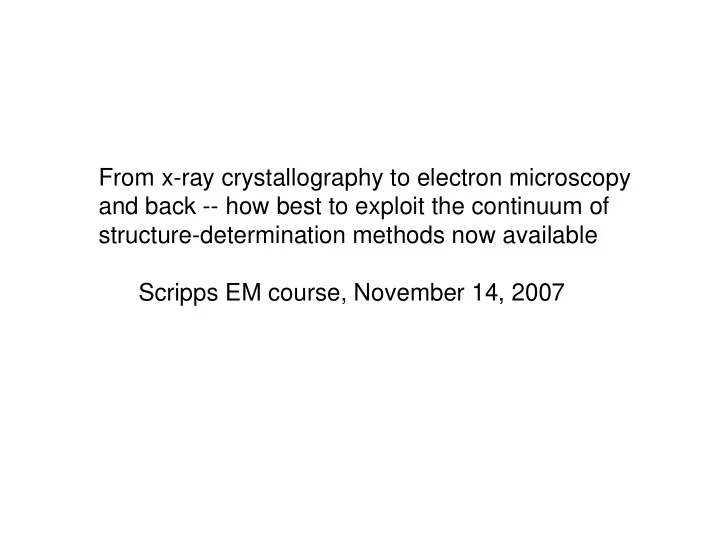

From x-ray crystallography to electron microscopy and back -- how best to exploit the continuum of structure-determination methods now available Scripps EM course, November 14, 2007
What aspects of contemporary x-ray crystallography have made it a particularly powerful tool in structural biology? • Molecular replacement: the body of pre-existing structural knowledge simplifies a new structure determination • Density modification: elimination of noise by imposition of “reality criteria” in direct space • Refinement: constraints enable you to incorporate chemical “reality criteria”
1. Phasing x-ray data from EM (TBSV; reovirus core) 2. Phasing electron diffraction data from coordinates derived from x-ray crystallography (aquaporin) 3. Docking an x-ray structure into an EM map (clathrin coat) 4. Lessons from x-ray crystallography for single-particle EM
X-ray crystallographic structure determination Experimental phases → map → (modified map) → build model 1. Experimental phases are poor; density modification is useful whenever possible. Building rarely produces complete or fully correct model: model → refine → rephase → rebuild and extend model → refine → (cycle) MR phases → map and MR model → rebuild or extend model 2. → refine → (cycle) Map is strongly biased, so it is much better to modify map based on solvent flattening or ncs, then continue with rebuilding and extending
Examples: phases from EM map as MR “model”, density modification from non-crystallographic symmetry (icosahedral: 5-fold in these two cases) TBSV: negative stain, 30 Å (1974) Reovirus: cryo, 30 Å (2000)
Protease σ 1 σ 3 μ 1 λ 2 σ 2 λ 1 μ 1 σ 3 σ 1 Virion ISVP Core infectious or intermediate subviral particle Dryden, Baker et al . (1993).
Crystals of reovirus cores F432, a= 1255 Å Initial phases to 30 Å from modified EM density Phase extension by averaging
Averaging as basis for phase extension in x-ray crystallography Map → Mask, average, and reconstitute → SFs F’s and ϕ ’s Works because true a.u. is smaller than crystallographic a.u., transform is effectively oversampled
Non-cryst. symmetry averaging and solvent flattening F, ϕ c F, ϕ → F c , ϕ c ↓ FFT FFT ↑ map → map' dens. mod.
Aquaporin-0 (AQP0): Molecular replacement with MOLREP, monomer as model Must refine unit cell (grid search) Refinement with CNS 1. Rigid body with unit-cell variation 2. Simulated annealing; rebuild from 2Fo-Fc with solvent flipping maps and SA omit maps to correct Gonen et al, 2004
Gonen et al, 2005 Aquaporin-0 (AQP0):
Docking a model from x-ray crystallography (or NMR) into a cryoEM density Two key resolution barriers: ~ 8-9 Å and ~ 4 Å Rigid-body refinement vs. more flexible refinement
Transferrin/TfReceptor Cheng et al (2004) Cell 116:565-576.
Molecular replacement: 1. Can a molecular model work as an initial reference for single-particle alignment, with appropriate filtering of spatial frequencies? 2. How can we best exploit molecular replacement in 2-D crystallography?
Clathrin coat 1. Density modification 2. ncs symmetry averaging Fotin et al, 2004
assembly - disassembly Assembly and of clathrin coats disassembly of clathrin coats uncoating vesicle formation cargo adaptor receptor clathrin
Anatomy of a clathrin coat C C N proximal knee distal ankle linker terminal domain N Clathrin lattice Triskelion = 3 x (Heavy Chain + Light Chain)
QuickTime™ and a Cinepak decompressor are needed to see this picture.
Musacchio, Smith, Grigorieff, Pearse, Kirchhausen Musacchio slide here D6 barrel
X-ray structure of clathrin fragments Proximal Region N-terminal Domain 1675 1000 500 1 Ybe et al, 1999 terHaar et al, 1998
Comparison of EM and X-ray densities at 7.9 Å Top View Side View EM X-ray
Clathrin CHCR domain organization Proximal Region N-terminal Domain 1675 1000 500 1 CHCR7 CHCR6 CHCR5 CHCR4 CHCR3 CHCR2 CHCR1 CHCR0 N-terminal Domain 1675 1000 500 1
Modeling structure of the whole leg CHCR7 CHCR6 CHCR5 CHCR4 CHCR3 CHCR2 CHCR1 CHCR0 N-terminal Domain 1675 1000 500 1
1 N-terminal Domain The helical tripod CHCR0 500 CHCR1 CHCR2 CHCR3 CHCR4 1000 CHCR5 CHCR6 CHCR7 H 1675
Two questions: 1. Can we improve a reconstruction by use of a model built into the density as reference? 2. Can we refine a model against the observed data (projected images)?
In crystallography, measured amplitudes are, by experimental arrangement, coming from an averaged structure. In single-particle EM, measured projections contain unique “noise” that will disturb estimate of projection parameters
X-ray: observations are amplitudes; refine model parameters against these observations, using chemistry as a constraint. If the model is incomplete, use refinement to improve phases, get better map, extend model. refine F.T. build Model → Model ′ → Suitable map → Model ″ Refinement minimizes: ∑⎪⎪ F i calc (h;x) ⎪ - ⎪ F i obs (h) ⎪⎪ 2 R = ⎯⎯⎯⎯⎯⎯⎯⎯⎯⎯⎯⎯⎯ ∑ ⎪ F i obs (h) ⎪ 2
EM: observations are projections; what parameters should be refined? Do we have enough power to refine against the following agreement factor? ∑⎪σ i calc (u,v; x, θ i ) - σ i obs (u,v) ⎪ 2 R = ______________________________________ ∑⎪ σ i obs (u,v) ⎪ 2 calc is the calculated projection, as a function where σ i of x, the model coordinates (and B’s), and of θ i , the orientation and origin of the i th projection If not, what is a suitable compromise?
Would hope to have the following cycle: refine reconst build Model → Model ′ → Suitable map → Model ″
Karin Reinisch Tom Walz Tamir Gonen Niko Grigorieff Yifan Cheng Piotr Sliz Tom Kirchhausen Alex Fotin David DeRosier
X-ray: observations are amplitudes; refine model parameters against these observations, using chemistry as a constraint. If the model is incomplete, use refinement to improve phases, get better map, extend model. refine F.T. build Model → Model ′ → Suitable map → Model ″ Refinement minimizes: ∑⎪⎪ F i calc (h;x) ⎪ - ⎪ F i obs (h) ⎪⎪ 2 R = ⎯⎯⎯⎯⎯⎯⎯⎯⎯⎯⎯⎯⎯ ∑ ⎪ F i obs (h) ⎪ 2
Recommend
More recommend